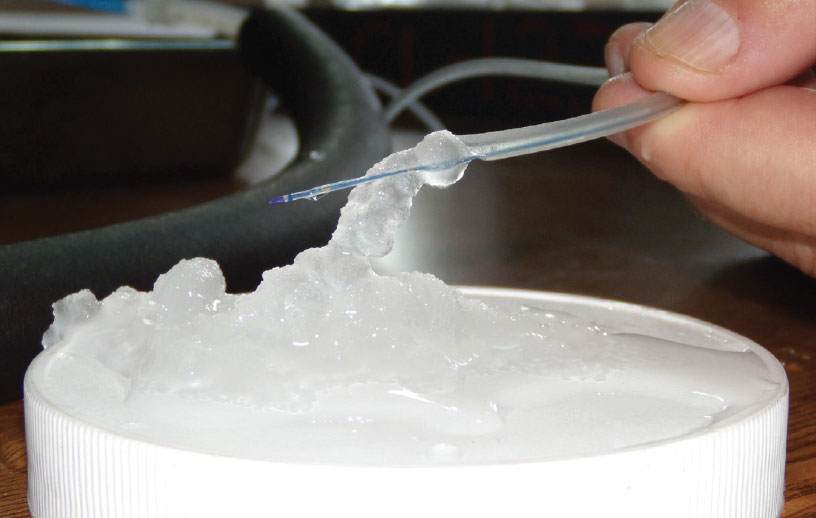Therapeutic Hypothermia - Protective Cooling Using Medical Ice Slurry
Surgical procedures are pushing the limits of technical excision and becoming less invasive through the development and use of laparoscopic procedures. There is an unmet need to protect critical organs through the course of surgical manipulations and during medical emergencies, such as cardiac arrest, stroke, and spinal or head trauma.
Presently, cardiac and cardiovascular surgeons often use bypass heat exchangers to induce protective cooling, which is slow to implement and quite invasive. External cooling with ice packs, blankets, caps, and jackets is sometimes used for inducing protective hypothermia. However, external cooling is very slow (< 0.03°C/min) and, as in bypass methods, cools the entire body, often causing adverse secondary effects (such as uncontrolled shivering or arrhythmias). Cooling the whole body frequently fails to protect a specific organ from ischemia (damage due to inadequate blood supply) because of failure to achieve the temperature believed to be most protective for that organ.
Technology Description
Medical ice slurry protective cooling is based on the premise that the ability of organs and tissue to survive ischemia, reperfusion damage, and surgical insults is improved by cooling rapidly in 5–15 minutes 4–15°C (depending on the organ) below the normal temperature of 37°C. Cooling slows metabolism and reduces the need for oxygen, which slows cell death—providing more time for medical treatment.
Argonne scientists have developed a proprietary method and equipment for making an ice slurry coolant to induce therapeutic hypothermia. The equipment makes slurry in less than two minutes, is easy to use, and delivers it selectively to a specific organ.
Argonne’s proprietary ice slurry has a high ice concentration and 4–7 times the cooling capacity of chilled water, an attribute that minimizes the disruption of blood or body chemistries. Small ice particles (less than 100 micrometers) in the slurry dramatically improve slurry ice loading and fluidity and enable the slurry to be stored more easily. As a result, the ice slurry can be pumped easily through very small diameter catheters or laparoscopic ports. The slurry can be made by using any biologically compatible carrier liquid, such as saline solution or a blood substitute.
Argonne scientists have developed a portable and fully automated prototype for medical slurry production and delivery. The system makes sterile medical ice slurry that is of uniform consistency and is deliverable through narrow catheters. The device not only delivers slurry as needed and tracks the amounts of slurry used and remaining, but it also monitors the temperature of the target organ.
Proof-of-concept studies have been completed in animals for laparoscopic kidney surgery and cardiac arrest, while proof-of-concept studies in animals for additional applications and clinical trials with human laparoscopic kidney surgery are being pursued. Argonne’s technology is ready for transfer to industry for commercial development.
Potential Benefits
Argonne’s portable, fully automated medical slurry production and delivery system gives surgeons the ability to selectively cool a specific organ to a protective temperature. This system can help to increase the survival rate of cardiac arrest patients and reduce brain damage due to lack of blood supply during surgical procedures.
In addition, the technology can be used in the treatment of various other medical emergencies, including stroke, brain injury, heat stroke, fever, and severe trauma. Protective and targeted cooling of organs helps to keep them viable during surgery when their blood supply is cut off. Another benefit of this medical ice slurry production and delivery system is targeted cooling for organ harvesting.
Technology Area
- Emergency care for cardiac arrest, stroke, heart attack, brain injury, and severe trauma;
- Protective and targeted cooling of organs during any surgery that requires prolonged cutoff or significant reduction of blood supply to the organ;
- Targeted cooling to improve organ viability from harvesting for transplantation.
Product
Portable and fully automatic medical ice slurry production and delivery system
Development Stage
Ready for transfer to industry for commercial development
Scientific Publications
- Microparticulate Ice Slurry for Renal Hypothermia: Laparoscopic Partial Nephrectomy in a Porcine Model
- Development of Ice Slurry Phase-Change Coolants for Industrial and Medical Applications
- Ice Slurry Medical Protective Organ Cooling: Buying Surgeons and Emergency Responders More Time
- Video: Laparoscopic Partial Nephrectomy with Ice Slurry as Coolant in the Porcine Model
Reference
Case No. ANL-IN-99-062, ANL-IN-03-118, ANL-IN-04-008, ANL-IN-05-005, ANL-IN-07-047, ANL-IN-07-093


